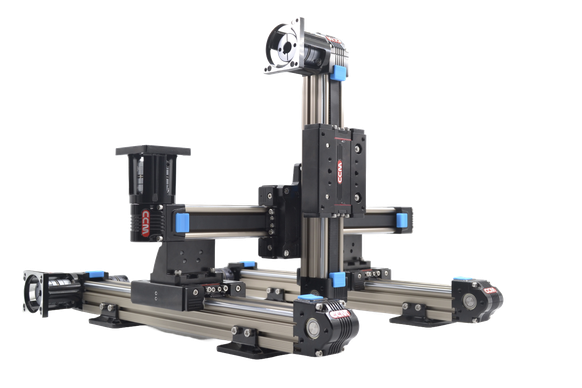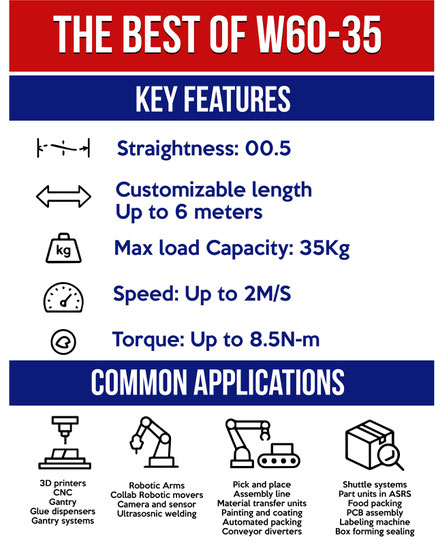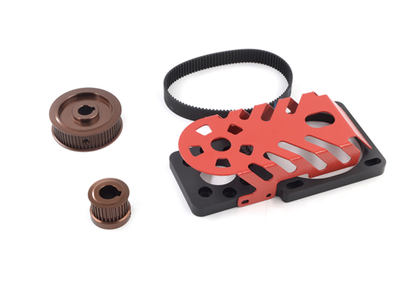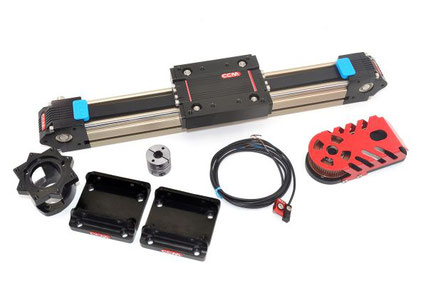CCM W60-35 Linear guide rail belt driven for cartesian robots.

Looking for the Right Linear Guide Rail for Your Application?
We understand how overwhelming it can be to choose the right linear guide rail when so many options online look similar and claim high performance. That’s why we’ve made it simple for you.
You have two clear options:
1. Stay here and check the technical specifications of our precision-engineered linear guide rail modules.
or check
2. How to Choose the Right Belt-Driven Linear Rail—Without Wasting Time or Money. Avoid common pitfalls, decode tech specs, and find the rail that fits your application perfectly.
Technical parameters W60-35
-
Guide Width: 60 mm
-
Max Load: 35 kg
-
Pitch: 95 mm
-
Synchronous Wheel Spec: STD5M-19Z
-
Recommended Speed: ≤ 2 m/s
-
Customized Length: Up to 6 meters
-
Input Torque: ≤ 8.5 N·m
-
Belt Spec: PU-5M-20 (steel wire)
-
Straightness: 0.05 / 300 mm
-
Applicable Motors:
-
Stepper Motor: Nema 57/86 (DC/Speed Reducer Set)
-
Servo Motor: 750W (Direct Connection), 200W/400W (DC/Speed Reducer Set)
-
-
Suggested Length: Effective stroke + 310 mm
-
Length Adjustments: Increments of 50 mm (e.g., 1000 mm, 1050 mm, 1100 mm)
This is the technical overview for the W60-35 linear motion module. If you require the full data sheet of the technical parameters, please contact us.

Features
-
High Precision – Engineered for accurate, repeatable motion in demanding applications.
-
Custom Lengths (up to 4 meters) – Tailored to fit your exact design and space requirements.
-
Corrosion-Resistant – Built with materials that withstand harsh environments and extend service life.
-
Maintenance-Free Operation – Designed for long-term use without regular servicing.
-
Ultra-Quiet Performance – Operates smoothly with minimal noise, ideal for sensitive settings.
-
Low Vibration – Ensures stable, consistent movement even at high speeds.
-
Trusted Reliability – Proven performance with minimal downtime across industries.
-
Long-Lasting Durability – Withstands continuous use under heavy loads and extended cycles.
-
Modular & Expandable – Easily integrates with accessories, sensors, and multi-axis systems.
Applications
-
Robotic Arms – Enables precise, repeatable linear motion for multi-axis automation.
-
3D Printers – Supports smooth, high-speed movement for accurate layer deposition.
-
CNC Router Machines – Ensures stable, rigid travel for cutting, milling, and shaping tasks.
-
Pick-and-Place Systems – Delivers fast, accurate positioning for high-throughput assembly lines.
-
Adhesive Dispensing Systems – Maintains controlled motion for uniform glue application.
-
Automated Painting Machines – Provides smooth, vibration-free movement for even coatings.
-
Packaging Equipment – Supports efficient and synchronized operations in automated packing lines.
-
Industrial Coding & Labeling Machines – Enables precise product marking and serialization.
-
Gantry Robots – Ideal for large-area, multi-axis systems requiring synchronized linear travel.
How to order
-
Tell Us About Your Project
Share your application details, goals, or challenges—our team is here to help. -
Provide Key Specs
Let us know the load weight, stroke length for each axis, travel speed, structure type, or environmental requirements. -
Receive a Tailored Quote
We’ll assess your needs and send you a detailed cost estimate—fast and accurate. -
Confirm & Start Production
Once payment is received, we’ll move your order into production with precision and care. -
We Handle the Shipping
We arrange safe and efficient delivery to your door, anywhere in the world.
-
Share Your Feedback
Your input matters—let us know how we did so we can keep improving.
⚠️ Top 5 Things You Should Not Do When Building a Cartesian Robot

Avoid these common mistakes to save time, money, and headaches.
Building a Cartesian robot is a smart choice—but even smart builders fall into these traps. Here’s what not to do if you want a smooth, accurate, and reliable system:
1. ❌ Don’t Use Cheap or Inconsistent Motion Components
Low-quality rods, wobbly rails, or friction-heavy slides will ruin your precision.
✅ Use belt-driven linear guide actuators with sealed bearings and hardened rails for smooth, accurate motion. Your robot is only as good as the rails it runs on.
2. ❌ Don’t Ignore Frame Rigidity
A weak or misaligned frame leads to vibration, backlash, and imprecise movement.
✅ Use sturdy aluminum or steel extrusions, check alignment carefully, and reinforce critical joints.
3. ❌ Don’t Overload or Underspec Motors
Too much load? Your steppers will skip. Too little torque? Your speed suffers.
✅ Match your motors and drivers to your payload, speed, and duty cycle. Don’t guess—calculate.
4. ❌ Don’t Neglect Cable Management
Dangling wires and messy connections lead to wear, interference, and failures.
🔧 Use drag chains, shielded cables, and organized routing from the start. It’s harder to fix later.
5. ❌ Don’t Skip Testing and Calibration
No robot runs perfectly out of the box.
✅ Take the time to tune acceleration, steps/mm, backlash compensation, and squareness. Fine-tuning = performance.
🧠 Final Tip:
A well-built Cartesian robot runs like clockwork. Focus on motion quality, structural stability, and smart design from day one—and your robot will pay you back in reliability and precision.
Need expert guidance or actuator recommendations? We're here to help you build it right.
Accesories for linear guide rails


